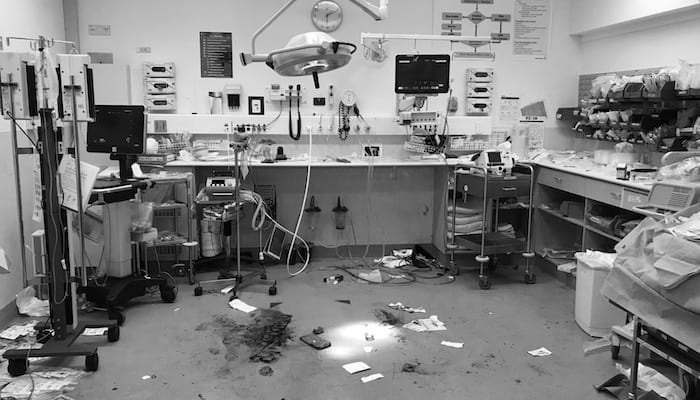Choose Your Own Resus Adventure
aka Ruling the Resus Room 003
One day, in a town not far from here, the anaesthetic registrar (yep, you again) is busy working up the next patient for an elective dual hip, dual knee replacement in an otherwise well (tight AS, pulmonary HT, bilateral CVAs and dementia) 98 year old lady from a nursing home, when the overhead page goes off…
Code Blue, Ward 12. Code Blue, Ward 12.”
Dragging yourself away from the 12 page summary of your patient’s medical problems, you realise that you are on Ward 12 already. Damn! You were just about ready for your 12th tea break for the day…
On arrival at the Code Blue, you see that the patient is an obese lady, who appears to have arrested during dialysis. She has minimal respiratory effort, and there are questions being raised about whether she has a pulse. She has tinges of blue on her lips and fingers. She was sitting in the dialysis chair and thankfully the nurses have flattened the chair out. One nurse has grabbed the Bag-Valve-Mask (BVM), and is providing basic airway manoeuvres.
What are your immediate priorities?
- (a) Take the BVM from the nurse and take over control of the airway.
- (b) Take a moment to consider current Basic Life Support (BLS) guidelines.
Click here if you chose (a)
You grab the BVM from the nurse and try to provide basic airway support. In your rush to be a hero, your hand is stabbed by the two dialysis needles, amazingly directly cannulating a vein AND an artery on your left hand.
Before you know it, you are being dialysed with 300ml/min of Hep C positive blood. As you drift into unconsciousness, you vaguely remember a mnemonic (DRS ABC) but you can’t for the life you remember what the D stood for.
6 months later you die a slow and painful death from fulminant liver failure.
Click here if you chose (b)
Great work!
Your priorities are to initiate or continue Basic Life Support (BLS) and Advanced Life Support (ALS). Current BLS guidelines use the mnemonic “DRS-ABC”.
What does D stand for?
Dangers
The potential dangers here include dialysis needles, the potential for blood / exsanguination to be the cause of the arrest and whether the patient is stable in the chair. You assess the dangers – the nursing staff are disconnecting the dialysis machine, and the cannulae are now safely away. There appears to be no blood lying around and she appears to be secure on the dialysis seat.
What does R stand for?
Responsiveness
This has already been assessed, and the patient is unresponsive. Oh dear, it looks like this one is for real…
What does S stand for?
Send for help
(cough, gulp).
They already have, and for the moment, you are it! Someone is grabbing the arrest trolley, so it’s time to get stuck in.
What is your next priority?
- (a) A,B, and C?
- (b) Grab the medical registrar, and ask her to run the code.
Click here if you chose (b)
You grab the medical registrar, and ask her to run the code. She looks at you with wide-eyed terror, and scampers off to do a long case. You turn around and look for the next available doctor. Even though there were 5 here a moment ago, now they all seem to be busy doing discharges, arguing with the ID registrar about whether they can give a 3rd generation cephalosporin, or flirting with the nurses. By the time you get back to the patient, the Coroner’s assistant is tapping you on your shoulder, asking you how to spell your last name.
Click here if you chose (a)
Well done!
What is A, B and C?
Airway, Breathing and Circulation
In most arrest situations, A, B and C are addressed simultaneously.
The nurse has thankfully initiated basic airway manoeuvres. But the patient is a large woman with a short fat neck. There appears to be no chest movement! You note the position of the dialysis chair – even when stretched out flat the chair is not ideal for resuscitation. As you can see from the picture, a flat dialysis chair is far from being a bed.
Airway control and ventilation are our first hurdles. With any airway problem, there are several options.
What is the best way to manage this airway?
- (a) You start with Bag-Valve-Mask ventilation.
- (b) You grab the laryngoscope and give it a go!
Click here if you chose (b)
You grab the laryngoscope, and ask the nurse for a size 7.0 tube. You have a look with the blade, but all you can see is pharynx. You look, and reposition, and look again. No luck. You decide to blind intubate with a bougie. The bougie goes in easily. A little too easily, you think.
Oh well, your next priority is circulation. You connect the ventilator, and continue CPR. The patients’ stomach slowly but surely insufflates with 100% oxygen. The coroner now knows how to spell your last name. Congratulations, you just turned the laryngoscope into a murder weapon.
Click here if you chose (a)
Awesome!
With any airway problem, try to keep it simple.
- Basic airway manoeuvres: including BVM, chin lift, jaw thrust, repositioning
- Supraglottic airway devices: Guedel airway, NPA, LMA
- Endotracheal airway devices
- Surgical airway
It is important to work through these quickly but in a step-wise manner. Most airway problems can be solved by optimal application of the first two measures.
You take the BVM and with your short fat fingers you provide jaw thrust and a tight BVM seal. Surprisingly you get some chest movement. This is good! But it’s not good enough. Your hand is getting tired, and you couldn’t maintain this for very long.
What are your next options?
- (a) Now, you can grab a laryngoscope and have a look.
- (b) Consider further basic airway manoeuvres or supraglottic devices.
Click here if you chose (a)
You grab a laryngoscope and have a look. It’s all mucousy and swollen. You can’t see a thing. It’s clearly an obstructed airway.
You remember that an obstructed airway is a surgical emergency, and you perform a needle cricothyroidotomy. “It’s Ok,” you tell the charge nurse, “it’s my third one this week…”. The anatomy is hard to define, but you are pretty sure the needle is in the right spot. And who cares right? It’s do or die!
Once attached to the ventilator, there is good air entry… into the neck and subcutaneous tissues. The coroner now has you on speed dial.
Click here if you chose (b)
Well done!
You could continue with basic airway manoeuvres, or move on to supraglottic devices. Because you can ventilate and maintain an airway with BVM ventilation, it is arguable that endotracheal intubation is still not indicated immediately. The intensive care registrar arrives, and with 2 person BVM, (one person holding the mask, and another providing bag compression) you get good chest movement. You are happy the airway is ok – for now!
Whilst all this is going on, someone tells you, whilst palpating the radial artery “She doesn’t have a pulse.”
What do you say?
- (a) “Look, these damned renal patients have notoriously poor pulses, usually due to PVD. Let’s just get a 12 Lead ECG on them and see what the ECG shows.”
- (b) “Thank you – I need two people to feel for a femoral pulse now, and I want 3 people to get ready to start CPR.”
Click here if you said (a)
The nurses go down the corridor to get the ECG Machine. It’s currently being used on a patient with VRE, but will be there in 3-5 minutes, after it has been wiped down and decontaminated. Meanwhile, you agree to allow a 3 lead ECG on the monitor, commenting, “You really need a 12 lead ECG to diagnose most problems.” When the ECG is connected it shows a sinus bradycardia at a rate of about 5 or 6 per minute. You spend a minute calculating whether it is actually 5 or 6. You start up an isoprenaline infusion and decline all offers of CPR.
3 months later, your wife accuses you of having an affair because you are spending all of your time at the Coroner’s office.
Click here if you said (b)
Great work!
It IS likely this patient DOES NOT have a pulse. The radial artery may not provide an accurate assessment of circulation. However, there are other clues to the lack of circulation – the lack of respiratory effort, lack of responsiveness, and she is turning blue.
You ask 2 people to palpate the femoral arteries, whilst the ICU nurse places the defib pads.
There is no femoral pulse palpable…
What is the management?
- (a) Defibrillate.
- (b) Start chest compressions.
Click here if you said (a)
You grab the defibrillator, recalling the study that showed that early defibrillation is the key to good outcome in cardiac arrest. Hoping to be the first to notice when the pulse has returned, you place your hand on the carotid pulse and deliver a 200J biphasic shock.
The nurses have a vote and choose not to resuscitate you, believing it is in the patient’s best interests that you do not continue your efforts. You are nominated for the 2011 Darwin Awards, but come a disappointing 4th.
Click here if you said (b)
Congratulations!
This person needs chest compressions, and quick!
In fact, they probably should have already been started. You get a crew of 3 performing CPR, rotating every 60 seconds. During the first pulse check, you note the rhythm on the monitor is severe bradycardia, almost an agonal rhythm. You perform 4 cycles of chest compressions with adrenaline and atropine.
Whilst this is happening, the ICU registrar has inserted an Intubating LMA into her airway. You ask her for an airway update.
“I have an Intubating LMA in, and we are managing to ventilate her easily.”
You smile – this is good! We now ‘Own the Airway!‘ BUT, someone reading the notes says to you, “Hey this lady has a Grade 4 airway…Is that good?”
Is this good?
Click here if you think this is good
If you said yes, you think a Grade 4 airway is good, then you probably think an 18-hole golf score of 100 is good. From here, your doctoring career goes downhill faster than Tiger Woods’ marriage. You take the Coroner out to lunch because she is the only person who wants to talk to you these days.
Click here if you think this is NOT good
You’re correct!
A grade 4 airway is a potential disaster! Even more so in an obese patient, in cardiac arrest, who is malpositioned on a flattened dialysis chair. She also arguably needs a more definitive airway than an LMA (eventually), and this information is vital.
HOWEVER… it’s not all bad.
After all, even Tiger Woods has a new girlfriend and is back playing golf. You CAN oxygenate and ventilate! You have a supraglottic device which is working! AND you can BVM ventilate if you lose the LMA!
THIS is good!
By this time, during the 4th pulse check, the resident (whose only assigned job was to “Palpate the femoral pulse and don’t let go until I tell you!” ) says “I can feel a pulse”. “Great job !” you say, “Carry on, old chap!”
There is a sinus tachycardia on the monitor, and the blood pressure is 110/80. The sats are climbing to 95%… This is good – we have owned the Airway and Breathing, and now we own the Circulation too.
The ICU registrar asks …
“Do you want me to intubate her through the LMA?”
What are the arguments for and against?
Arguments FOR/AGAINST attempting intubation
Arguments FOR attempting intubation
This patient needs a definitive airway (eventually), for ventilation. This patient needs ICU. An ETT is more secure than LMA, especially when you are going to need to transfer the patient from the dialysis chair to a proper bed, and then transfer down to the ICU.
Arguments AGAINST attempting intubation
You are managing to oxygenate and ventilate (granted – through an LMA), and we have good airway control (for the moment). You are on a ward, with no senior support immediately available and no difficult airway trolley nearby. The patient is not in optimal position. The mantra “make your first attempt your best attempt” comes to mind. Finally, by attempting to intubate we MAY lose our airway, or cause laryngeal trauma or oedema.
You decide NOT to intubate, prompting puzzled looks from several of the other dialysis patients who had gathered around, wondering what all the fuss was about.
You say to the registrar…
Although I agree she needs a definitive airway, we should not intubate her right now. We know this person has a grade 4 airway, and her position is less than ideal. At this stage we have an airway, and we can oxygenate and ventilate. There is no hurry to insert an endotracheal tube.
Everyone agrees, and your initially controversial stance is affirmed…
What are your options to obtain a definitive airway?
3 options…. STAT!
The 3 options are:
- Transfer to ICU.
Once you are in ICU, with appropriate monitoring, an experienced anaesthetist and difficult airway equipment immediately available, then a plan should be made to intubate, along with a Plan B and Plan C. - Transfer her to theatre and do the same.
Depending on your hospital this may be easier or harder than in ICU, especially if you consider the availability of a theatre, or a space in ICU. - Call an experienced anaesthetist.
Ask them to bring the difficult airway equipment up.
Things that need to be considered in this process include the risks of losing the airway whilst moving the patient (particularly somewhere like a corridor or lift), versus the risk of attempting to intubate outside of theatre, and away from help.
There is no definitive answer to these issues.
You decide to call for senior help, as it is going to take 15 minutes to get the patient transferred to a proper bed. You call the Senior Anaesthetist and he arranges for some difficult airway equipment, and HIMSELF, to come up.
Whew! Crisis averted. Or so you think…
You take a breath.
While you are exhaling, the charge nurse comes up to you and says:
“This lady has an Advanced Care Directive, following discussions with Respecting Patient Choices. She doesn’t want CPR and doesn’t want ICU”.
Your heart sinks.
How do you manage this patient now?
- (a) Reconsider your plan, and discuss with family and senior clinicians?
- (b) Ignore the request, because you have already started (and you have triumphed against the odds!), and push for an ICU bed.
Click here if you chose (b)
You say:
“Look, we didn’t know that before we started and now we have successfully resuscitated this lady. We need to give her a chance! Her advance directive is 8 months old already – she may have changed her mind.”
On the way down to the ICU, she re-arrests 3 further times, needing CPR and high dose inotropic infusion. The ICU Consultant On-Call accepts the patient after hearing a rather manipulated story from her renal physician and oncologist about a “previously fit and well lady, with cardiac arrest, probably due to hyperkalaemia, which we have now corrected.” The patient languishes in the ICU for 3 days before dying. You ring the Coroner for advice on how to represent yourself, because there is no lawyer desperate enough for a paycheck to want to represent you.
Click here if you chose (a)
You made a great choice!
This is a difficult situation, but not uncommon.
You have successfully managed to resuscitate the unresuscitatable under trying circumstances using a simple, common sense application of BLS and ALS guidelines.
Now all your efforts appear to have been against the patients’ wishes. Your only consolation is that you were acting in good faith, and without knowledge of her wishes.
From here, the plan is clear, although each stage needs to be addressed delicately.
- confirm the patients’ wishes
- cease further resuscitation attempts
- consult with the family
- consult with senior clinicians and the team in charge of the patient
- initiate palliative measures if appropriate

CLINICAL CASES
Resus Room Reflection
Specialist Intensive Care Physician working at the Austin Hospital, Melbourne. Interests: Shoulder Dislocations, Pain Management, End-of-life care, Organ Donation and ECGs | Linkedin |






I like this case very challenging response to wrong answers are funny but worth of lessons